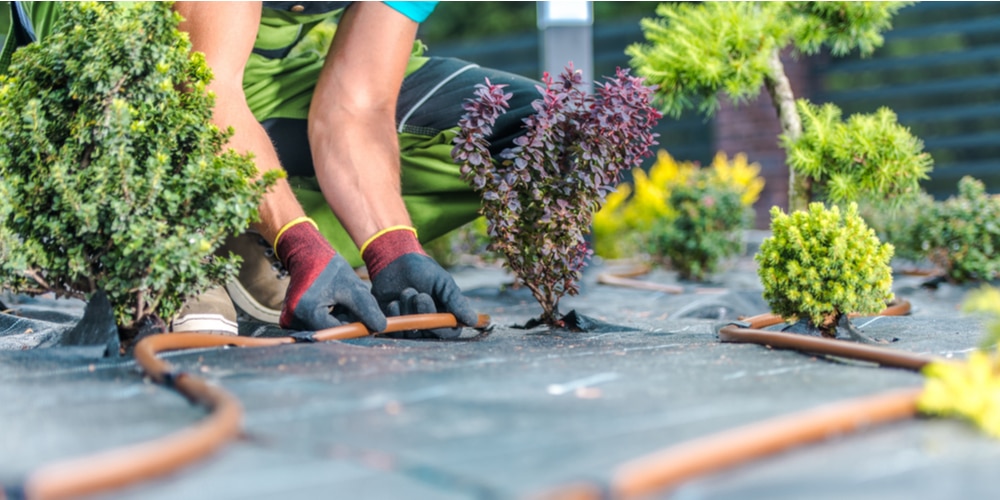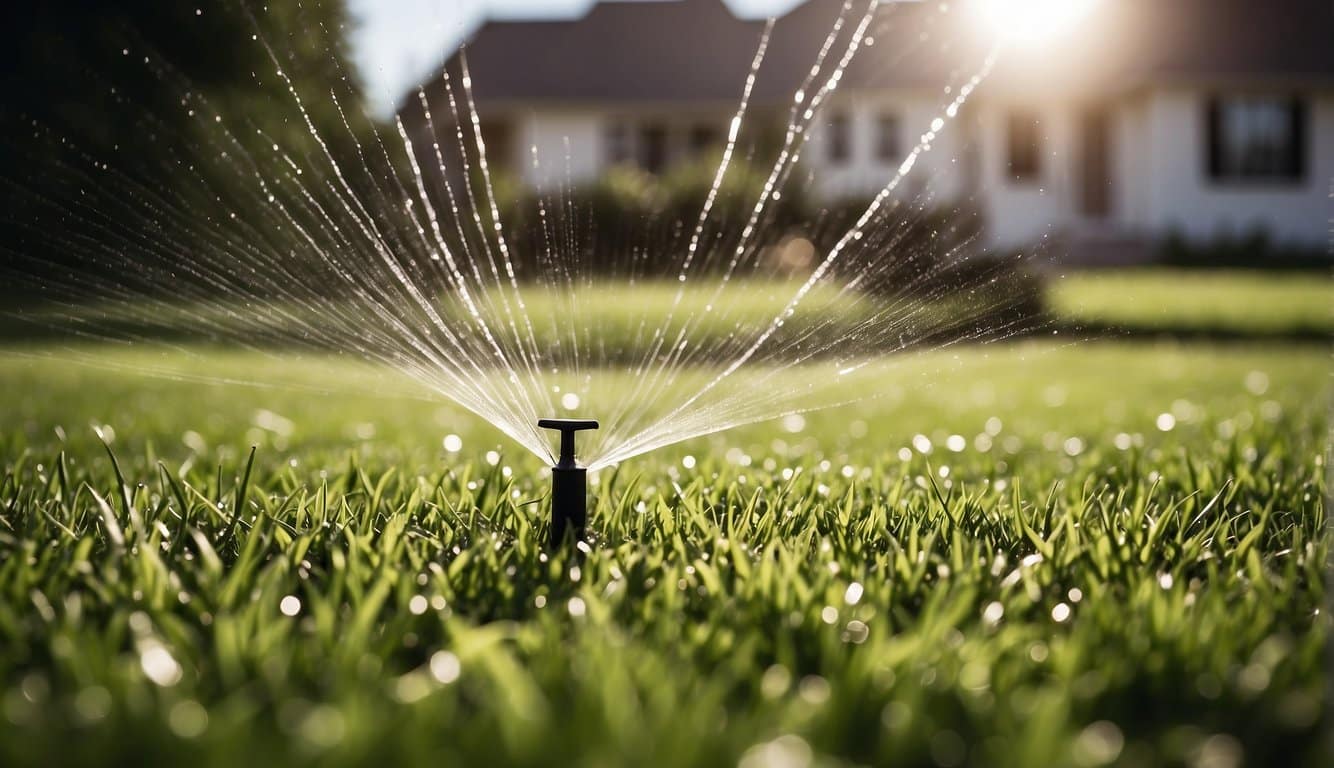Initial Check
Before the rush of spring growth, it’s crucial to assess your irrigation system to ensure it’s in peak operating condition.
This evaluation can prevent wasted water, reduce unexpected expenses, and support healthy plant growth.
Key Steps to Evaluate Your Irrigation System:
- Inspect All Components:
- Check for visible signs of wear and damage on sprinkler heads, valves, and hoses.
- Ensure all parts are firmly connected.
- Test the Water Pressure:
- Use a pressure gauge to verify that the pressure is within the system’s operating range.
- Too much or too little pressure can lead to inefficient watering.
- Assess Sprinkler Head Efficiency:
- Ensure that each sprinkler head is free from obstructions and properly aligned.
- Replace any that are damaged or malfunctioning.
- Check for Uniform Water Distribution:
- Place containers around your lawn to catch water from the sprinklers.
- After a normal cycle, measure water levels to check for even distribution.
- Monitor System Coverage:
- Watch for dry spots or overly saturated areas.
- Adjust the reach and arc of sprinkler heads as necessary.
- Evaluate the Timing System:
- Confirm that the timer or smart controller is set according to local weather conditions.
- Adjust the watering schedule to accommodate seasonal changes.
Cleaning and Repairing Components
Proper maintenance of your irrigation system is essential for optimal performance during the spring season. This involves thorough cleaning to remove any blockages and replacing parts that were damaged during the winter.
Clearing Blockages
Blockages in your irrigation system can lead to uneven watering or even damage if not addressed. Here’s how you can clear them out:
- Check each nozzle and sprinkler head to ensure they are free of debris. If any blockages are found, gently clean them out.
- Flush out the system by running water through the pipes after removing the nozzle ends, allowing any trapped dirt or debris to escape.
Replacing Damaged Parts
Winter can be harsh on your irrigation system, and damaged components need prompt replacement:
- Inspect sprinkler heads, valves, and pipes for any cracks or signs of wear.
- Replace any worn or broken parts with new ones to prevent leaks and maintain efficiency.
System Optimization
To ensure your irrigation system operates efficiently, it’s crucial to fine-tune key components such as sprinkler heads and timers. Proper adjustments lead to water conservation and a healthier landscape.
Adjusting Sprinkler Heads
- Check Each Head: Inspect individual sprinkler heads for clogs, damage, or misalignment. Clear any debris, and replace any parts that are worn or broken.
- Correct Angles: Aim the heads so that water is directed towards your plants and not onto buildings, sidewalks, or the street. This reduces waste and ensures effective watering.
- Even Coverage: Make sure each area of your lawn receives uniform water coverage. This may involve adjusting the arc or radius of the sprinkler heads.
Programming the Timer
- Set Accurate Times: Program the timer to water at optimal times, usually early morning or evening, to reduce evaporation losses.
- Adjust for Seasons: Change the watering schedule based on seasonal weather conditions. In spring, you might need less water due to increased rainfall.
- Use Rain Sensors: If your system is equipped with rain sensors, ensure they are connected and functional to avoid unnecessary watering.
Water Efficiency Testing
As spring approaches, it’s critical to ensure your irrigation system operates efficiently. Testing for water efficiency involves checking for leaks and conducting a coverage uniformity test.
Checking for Leaks
- Visual Inspection: Walk through your irrigation system and look for any signs of leaks such as pooling water or unusually wet areas.
- Component Check: Examine all hoses, connectors, and sprinkler heads for damage or wear that might cause leaks.
- Pressure Test: Attach a pressure gauge to a spigot near the irrigation system to check for pressure drops, which might indicate a leak.
- Tip: Perform this test when the system is running and when it’s off for comparative results.
Conducting a Coverage Uniformity Test
- Place Catch Cans: Distribute catch cans or straight-sided containers evenly throughout a zone to measure how much water these areas receive.
- Run the System: Activate the irrigation system for a set period to simulate a usual watering cycle.
- Measure the Collection: After running the system, use a ruler to measure the water in each container.
- Record the Results: Note the amount of water in each can to identify areas receiving too much or too little water.
- Adjustments: Based on measurements, adjust your sprinkler heads or system timer to ensure even water distribution across your yard.
Professional Assessment and Servicing
When preparing your irrigation system for the spring, a professional assessment and servicing is a crucial step to ensure optimal functionality. Experts possess detailed knowledge about the complexities of irrigation systems, which can be vital for preventing future problems.
- Certified Inspection: Schedule an inspection with a certified contractor. They can accurately assess your system’s condition, identify any wear or potential issues, and ensure all components, like backflow preventers and valves, function properly.
- Cleaning and Adjustments: Professionals will clean vital parts, such as the weather sensor and sprinkler heads, after uncovering them from the winter protection. They can make necessary adjustments for efficient water distribution and coverage.
- System Activation: Activation involves turning on the water supply and checking for leaks or damage. By going through each zone, they’ll verify that all areas of your landscape are receiving adequate moisture.
- Repairs and Upgrades: If any repairs are needed, or if upgrades could enhance system efficiency, a professional will handle them with expertise. This might involve sprinkler repairs or implementing smart controllers and sensors for better water management.
- Education: You’ll get personalized advice on maintaining your irrigation system and learn how to adjust settings, like watering schedules, to suit the seasonal needs of your landscape.
Frequently Asked Questions
Preparing your irrigation system for spring involves several key steps to ensure it operates efficiently. Here’s what you need to know to get your sprinkler system up and running after the winter months.
What steps should be followed to activate a sprinkler system after winter?
- Slowly open the main water valve to prevent a surge that could cause pipe damage.
- Check each sprinkler head for blockages or damage.
- Run the system zone by zone to ensure even water distribution and to observe for any operational issues.
What is the recommended timing for starting sprinkler systems in the spring?
- It’s best to start your sprinkler system in the spring after the last frost date to avoid freeze damage.
- The specific timing can vary by region, so consider local climate patterns before activation.
How to check and troubleshoot sprinkler systems before the spring season?
- Inspect for broken heads and clogged nozzles which can impede water flow.
- Look for signs of leaks which can be caused by cracked pipes or loose joints.
What is the correct procedure to de-winterize an irrigation system?
- Remove insulation from the system components.
- Gradually open the main valve and flush the system to clear out any debris.
How can I inspect my sprinkler system for damage prior to spring usage?
- Manually inspect each component including valves, pipes, and sprinkler heads.
- Be on the lookout for cracks or wear and tear that may have occurred during the winter.
What precautions should be taken to prevent freeze damage when preparing a sprinkler system for spring?
- Ensure all the water is completely drained from the system before the first freeze.
- Use insulation covers for above-ground components to protect against subsequent freezes.
Last update on 2024-05-02 / Affiliate links / Images from Amazon Product Advertising API




